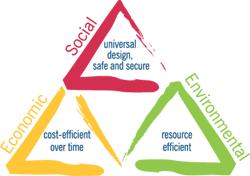
We are very pleased to have our inaugural guest post by John Salmen, AIA. A licensed architect, John is President of Universal Designers and Consultants, Inc.. John has specialized in barrier free and universal design for 30 years and is a recognized expert on US accessibility regulations and a leader in the field of Universal Design. We can think of no one better to start the accessibility discussion on our blog, and we also believe John makes an interesting, persuasive and important connection between economic, environmental and social sustainability that merits significant attention.
Inevitably, this question must be raised. As public awareness of green design swells to a tidal wave, many Students of Universal Design (UD) think we see the next wave approaching – and its name is Universal Design. But how do these waves relate to each other? Are they random swells? Or caused by undersea movement of the earth’s crust?
Valerie Fletcher, Executive Director of the Institute for Human Centered Design, and Elaine Ostroff, Founding Director along with Eric Mikiten, AIA of the Bay Area COTE, believe that they are both connected to the earth shaking movement of Sustainability. Eric presented his overview in detail at the AIA 2009 convention. The trefoil logo, developed by the Department of Public Works of Queensland, Australia for its Smart House program (www.build.qld.gov.au/smart_housing/elements/index.asp), communicated how these three universal design leaders visualize the “ three–legged stool of sustainable design.” The graphic above illustrates how universal design is a basic element of sustainable design, as it relates to resource efficiency and economic empowerment under the umbrella of environmental, economic and social sustainability.
Environmental sustainability relates to the green movement and natural resource conservation and efficiency. Economic sustainability relates to concepts of life cycle costing, equity and fair trade value of products and services. Social sustainability relates to systems that support people by creating safe, secure and independent communities.
When compared to financial and natural resources, human ability is arguably the most precious resource of all. Human ability is enabled, supported and encouraged by a universally designed environment that gives everyone the opportunity to participate with a minimum of outside support. Just as we must conserve our natural resources, we must also conserve our human resources. It is a waste of human potential to create environments that demand dependence when a simple change in the design of the path, space or element could allow un-assisted use. Like “green design”, universal design must be an integral part of design programming and the imaginative design process. It cannot be left as an add-on in a minimal compliance mode.
The relationship between two people who are locked in the care giver/receiver dance, while frequently a loving and enriching experience, is difficult, uncomfortable, and too often destructive of human dignity. Independence is best and can be extended with universal design. The obvious example is aging in place, which is facilitated by universally designed homes and communities.
As we struggle to make the most of limited resources, the value of universal design as a tool to conserve human resources will become increasingly apparent, and its relationship to the broader goal of sustainability will become clear.
Editor’s post script: In response to Chris Cheatham’s fair question of what is “Universal Design”, here is a definition from John Salmen’s website:
Ron Mace, one of the original universal design movement leaders, defined universal design as: “Universal Design is the design of products and environments to be useable by all people, to the greatest extent possible, without the need for adaptation or specialized design.

